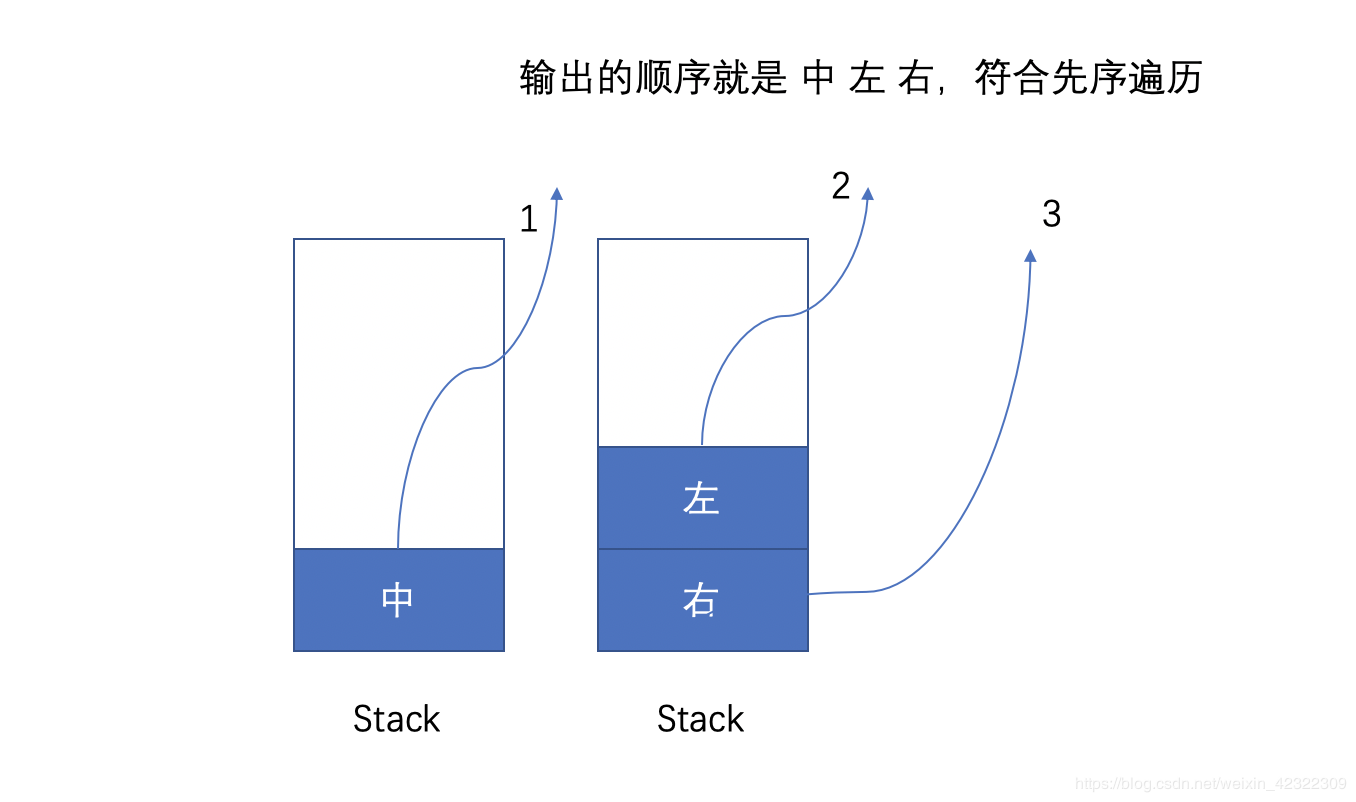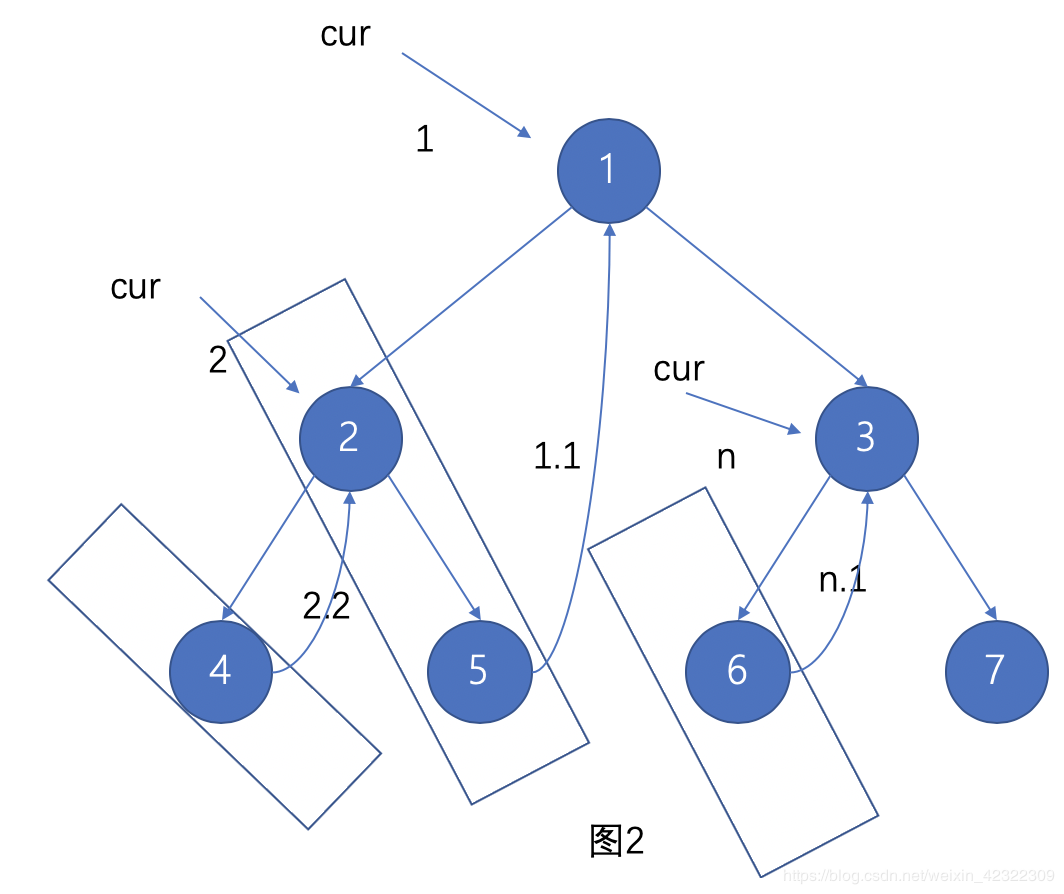非递归方法遍历二叉树
二叉树遍历是经典的算法题目,最传统的方案是使用递归的方式进行遍历,特点是代码非常简洁。当然,除了递归方案,二叉树也可以使用 迭代的方法进行遍历。具体的,包括两种思路,一种是使用程序栈模拟递归过程,第二种是利用叶子结点 的 null 子节点模拟线索二叉树完成遍历(Morries 方法)。本文将对他们进行总结归纳。
LeetCode 上三种遍历的题目如下,可以用来测试:
1. 模拟递归栈解法
仔细分析二叉树遍历递归的过程,我们发现可以 在迭代中使用 stack 来模拟系统栈,从而对递归进行模拟。
下面代码展示了 前序遍历 的过程:
1 | public List<Integer> preorderTraversal(TreeNode root) { |
具体过程如下图所示:

中序遍历 相对逻辑上复杂一些,它需要首先输入最右边的结点,因此,要保证最右边的结点位于栈顶。具体的流程参看下面的代码:
1 | public List<Integer> inorderTraversal(TreeNode root) { |
后序遍历 后序遍历是先遍历完左右子树,最后回到根结点。这一点上其实和 前序遍历有些类似 - 前序遍历是 中左右 的顺序,而 后序遍历可以看作是 “中右左” 的反顺序。
具体代码如下:
1 | public List<Integer> postorderTraversal(TreeNode root) { |
上述方法中使用了两个栈, 而另一种 后序遍历 则通过添加一个 cur 指针标记当前退出的结点,来减少一个栈的使用,因此更加推荐:
1 | public List<Integer> postorderTraversal(TreeNode root) { |
2. Morris 解法
不同于递归遍历和模拟栈遍历方法, Morris 遍历方法可以仅使用 O(1) 的空间复杂度对 二叉树进行遍历。由于不能使用 栈作为辅助空间,Morris 方法使用了 线索二叉树 (threaded binary tree) 的概念来辅助树的遍历。当然,Morris 方法不需要为每个结点额外分配空间指向其前驱(predecessor) 和 后继(successor),而是利用叶子结点中的左右空指针来实现到 后继结点 的跳转。
Morris方法的中序和 前序遍历较为简单,后序遍历则比较复杂。具体介绍如下:
中序遍历 首先以中序遍历为例子,介绍整个遍历思路。在遍历过程中,维护两个 指针,cur1 指针为指向当前所遍历结点的指针, cur2 指针则用于寻找当前节点的 中序遍历之前驱结点(参考线索二叉树的相关概念 – 具体就是左子树中的最右边的结点)。
初始状态:cur1 指向根结点。
然后只要 cur1 不为空,就继续遍历,遍历过程如下:
- 若 cur1 的左孩子为空:处理当前节点,cur1 指向 cur1.right。
- 若 cur1 的左孩子不为空,则使用 cur2 找到 cur1 中序遍历的前驱结点(即左子树的最右边的结点):
- 若 cur2 的右孩子为空,则将 cur2 的右孩子设为 cur1 – 建立连接。然后 cur1 指向 cur1.left;
- 若 cur2 的右孩子不为空(为 cur1),说明当前 cur1 的右孩子已经全部遍历完成,将 cur2 的右孩子恢复为 null。再 处理 cur1,并将 cur1 指向 cur1.right。
具体参考下方代码:
1 | public List<Integer> inorderTraversal(TreeNode root) { |
前序遍历 前序遍历基本借鉴了 中序遍历的思路,不同点有二:
- 在
cur2.right == null时,不仅建立连接,还同时处理结点。 - 在 中序遍历中,如果 cur1 结点左子树全部遍历完毕,则 添加 cur1 结点的 val。前序遍历只有在 cur1 左子树为空的情况才添加
cur1.val。即 前序遍历if(cur2 != null){....}else res.add(cur1.val);而中序遍历中,不需要添加 else。1
2
3
4
5
6
7
8
9
10
11
12
13
14
15
16
17
18
19
20
21
22
23
24
25public List<Integer> preorderTraversal(TreeNode root) {
List<Integer> res = new ArrayList<>();
if(root == null) return res;
TreeNode cur1 = root;
TreeNode cur2 = null;
while(cur1 != null){
cur2 = cur1.left;
if(cur2 != null){
// 寻找左子树的最右边的结点 -- cur1 中序遍历的前驱结点
while(cur2.right != null && cur2.right != cur1) cur2 = cur2.right;
// 若 cur2.right 为 null: 添加 cur2 到当前节点的连接并且 处理 cur1 结点
if(cur2.right == null){
cur2.right = cur1;
res.add(cur1.val);
cur1 = cur1.left;
continue;
// 若 cur2.right 不为 null,恢复它为 null
} else cur2.right = null;
// 如果 cur1 左子树为空,直接处理 cur1
}else res.add(cur1.val);
cur1 = cur1.right;
}
return res;
}
后序遍历 后序遍历相对复杂。前面的准备工作与 前序、中序比较类似,但遍历输出时,需要进行的改动较大。
如下图所示,后序遍历时将结点的连续右节点当成一个单链表来看待。当cur 返回上层时,我们 逆序处理 下层的单链表。例如,返回到 2 时, 处理链表 4 (该链表只有一个结点); 返回到 1 时,处理链表 5 -> 2 。

1 | //后序Morris |
参考:
[1] https://www.cnblogs.com/anniekim/archive/2013/06/15/morristraversal.html
[2] https://zhuanlan.zhihu.com/p/101321696
[3] https://leetcode-cn.com/problems/binary-tree-preorder-traversal/solution/leetcodesuan-fa-xiu-lian-dong-hua-yan-shi-xbian-2/
[4] https://leetcode-cn.com/problems/binary-tree-preorder-traversal/solution/tu-jie-er-cha-shu-de-si-chong-bian-li-by-z1m/